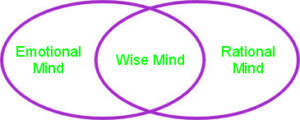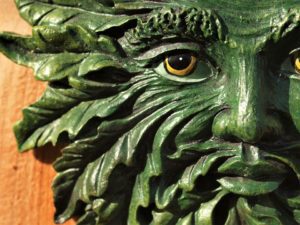Sometime later Coyote woke from his dream. The conversation he’d had with Chief Buffalo lingered in his mind and in his spirit as he stretched sleepily and rose to take a drink from the nearby creek. All this time he had though himself unworthy to take up this quest because of his nature, but the Chief Buffalo of the dream time had told him that it was his very nature that made him the perfect candidate for the quest in the first place!
Coyote had thought that he must somehow deny his true nature, the essence of his being, in order to complete the quest. But now he saw his nature as a Trickster was the very thing that would help him complete his quest. All he had to do was to trust his own inner wisdom.
He pondered the idea that it was strange that a dream should teach him this. After all, dreams come from within his own head, and because it was a dream, it meant that Chief Buffalo wasn’t really there talking to him. Some part of his mind had imagined that conversation.
But the more he thought about it, the more he realized that this wasn’t true. “What if we are all connected at some level?” He thought to himself, “What if a part of me is Chief Buffalo, and a part of Chief Buffalo is me? What if separation is an illusion, and we are all part of the same whole? What if there is only one Soul in the entire world, and we are all a part of it?”
The more he thought about this, the more it made sense.
“Chief Buffalo is holy, but so am I. White Buffalo Woman is sacred, but so am I. We are all part of the same whole. Whenever I need their assistance, all I need to do is remember that they are a part of me, and I am a part of them. With this knowing, I will always have their wisdom to call upon.”
“We are all holy,” thought Coyote. “We all are sacred. Everyone I
look upon is holy, and whatever ground my paws touch, it is sacred ground. My
eyes are holy, and everything I look upon is sacred. When I see my brothers and
sisters, I am seeing them as aspects of myself, in love and wisdom. Every day
and every night they will all be with me. No distance can separate me from
their love. From this day forward I am walking in a sacred manner upon the
Earth, and nothing and no one can ever take that from me. I can never go back
to the old way of being, for I have been re-born into this sacred wisdom.
Nothing…not even death…can separate me from this divine love. Knowing this, I
will never doubt myself again. I will never be afraid again.”
10.0 Apotheosis
“The only difference between you and God is that you have forgotten you are divine.”
― Dan Brown, The Lost Symbol
The word apotheosis comes from the Greek. It means, “To become divine or godlike.” For our purposes, apotheosis is the result of integrating the Shadow and the Persona. Divinity is usually associated with perfection, but in our version of apotheosis, this perfection doesn’t apply to some unrealistic and dogmatic ideal defined by others (or defined by the voices of the Father). “Perfect” in this sense means acting in ways that are perfect for you, and not anyone else. The way to achieve apotheosis is to learn to accept all of your perceived shortcomings, weaknesses, and darker impulses that dwell in the Shadow as a part of you. By embracing your whole being, you are able to turn weaknesses into strengths.
The first step in apotheosis is to examine all the things about ourselves we have tried to suppress in the Shadow. Are there any hidden strengths in these suppressed things? Could these things become sources of strength if we learned to express them in creative, positive ways?
What’s in your own Shadow? Just as Coyote attempted to suppress his own true nature as a Trickster, what impulses might you have been suppressing that are really a part of your own true nature? How might those feelings, thoughts, beliefs and behaviors be turned into allies and abilities on your seeker’s journey to True Self?
Sometimes such repressed impulses manifest in anger. We’re rarely taught to express anger in positive ways. Instead, when we feel angry, we’re told to deny those feelings rather than to express them. The problem with this is that angry people are passionate people. We get upset because we feel passionate about something. If we try to suppress the anger, we also run the risk of emotionally numbing the passion.
What if, instead of suppressing it, we could find positive ways to channel the passion of that anger? The Founding Fathers were angry at the way the British Empire was treating them, and they channeled that anger into fighting for independence. Martin Luther King was angry at civil injustice, prejudice, and bigotry, and he channeled that anger into fighting for equal rights, as did Gandhi, Susan B. Anthony, Abraham Lincoln, and a host of other historical icons. In fact, I would go so far as to say that most, if not all, great movements for change in the world began because someone was angry about the status quo. So anger itself isn’t the problem. It’s how we choose to channel the energy of that anger.
Perhaps it’s not anger that is suppressed in your Shadow, but some other emotion like sadness, fear, or anxiety. In such a case, the way to integrate those emotions from the Shadow is to ask yourself what your intention is in suppressing these emotions, and what might happen if you learned to express them in positive ways. If you wrestle with sadness and depression, could you support others who do the same? If your fears are being suppressed in the Shadow, could you learn to face your fears and channel that energy into positive resolutions? If you suffer from anxiety, could you confront it in ways that allow you to take advantages of the opportunity such stress brings?
Like Coyote, we can learn to use our Shadow energy for creative purposes. From Chief Buffalo, Coyote learned that he could use his gift of trickery as a teaching tool. In doing so, he would not have to go against his own true nature. Instead, he could channel his preference for pranks into positive activities that would help others learn.
To achieve apotheosis, first ask yourself what elements of your own Shadow you might have been suppressing. Next, ask yourself how these elements might be used in positive ways. When you are able to do this consistently, you will have learned how to accept who you are, warts and all. You will have learned that your own true nature is perfection. Nobody else can be a perfect “you” but you.
Once you have integrated Shadow with Persona, you will have come to the knowledge that all things are sacred. As Coyote realized in our story:
“We all are holy. We all are sacred. Everyone I look upon is holy, and whatever ground my paws touch, it is sacred ground. My eyes are holy, and everything I look upon is sacred. When I see my brothers and sisters, I am seeing them as aspects of myself, in love and wisdom. Every day and every night they will all be with me. No distance can separate me from their love. From this day forward I am walking in a sacred manner upon the Earth, and nothing and no one can ever take that from me. I can never go back to the old way of being, for I have been re-born into this sacred wisdom. Nothing…not even death…can separate me from this divine love. Knowing this, I will never doubt myself again. I will never be afraid again.”
When you come to understand this, you will have attained apotheosis.
10.1 Spirits in the Material World
“We are spirits in the material world.”
–Gordon Sumner (aka “Sting” of the Police), Spirits in the Material World
In order to understand apotheosis, we must first understand our own true nature. As Sting reminds us, “We are spirits in the material world.” The part of us that is divine is the part that is spirit. From the perspective of ecospirituality, we’re not talking about anything supernatural when we say “spirit.” We are talking about “that which inspires.”
Inspiration comes from Wise Mind.
When we are being logical, rational, and devoid of emotion, we are in Rational Mind. When we are allowing our thoughts to be driven by our feelings, we are in Emotional Mind. A goal of apotheosis in ecospirituality is to achieve Wise Mind. Wise Mind is the joining of Rational Mind and Emotional Mind in perfect balance and harmony. It is a moving beyond opposites to a mindful state of acceptance.
We sometimes tend to think of things in black-and-white terms. When in this mode of thought, we tend to see experiences as “all good” or “all bad.” But if we use our skills of mindful awareness to see what is really there, we may come to recognize that rarely are things all good or all bad. There is usually a little bit of bad in the best good things, but likewise there is usually a little bit of good even in the worst bad things. One of the skills of Wise Mind is seeing the gray areas of life for what they are instead of interpreting them as black or white.
Apotheosis in ecospirituality is about achieving balance. The way to gain this balance in our lives is through integrating our Shadow and our Persona, thus achieving Wise Mind. It is learning to live in the gray areas.
To look at an example of how this Wise Mind might appear in the real world, let’s imagine that a woman has stolen a loaf of bread to feed her children, who are starving. A person who is totally cold, calculating and logical, devoid of emotion, and operating solely from Rational Mind, might say something like, “Yes, it’s unfortunate that her children were starving, but the law is the law. She should be punished.”
But a person who is operating from Wise Mind has the ability to use a rational mind tempered by emotion. In this case, such a person might say something like, “The law is the law, but we should also have compassion. Who among us wouldn’t steal a loaf of bread if our children were starving?”
Let’s look at another example, this time from Emotional Mind.
Suppose I’m in line at the grocery store. I only have a few items, so I’m in the “ten items or less” lane. The person in front of me has a cart completely full of groceries. It’s obvious that she has far more than ten items.
If I’m operating from Emotional Mind, I might let my emotions get the better of me and make an angry comment to this person, causing a scene in the grocery store. But a person operating from Wise Mind in this situation might temper the emotional reaction with Rational Mind. Such a person might take the opportunity to say to himself, “This person is obviously going to be a while. I don’t need to let the fact that she’s breaking the rules ruin my day. Instead, I can take this opportunity to do a mini-meditation while I wait.”
When operating from Wise Mind, we are able to gain the wisdom to know what we have the power to change, and what we must accept. Once we have achieved this state of acceptance, we are able to integrate Shadow into Persona. This is because Shadow and Persona are part of the same whole that is Self. If we were to graph out the idea that Wise Mind is a blend and balance of Emotional Mind and Rational Mind, the graph would look like the illustration below.

10.2 Wise Mind: Doing vs. Being
Imagine you could recognize the divinity in yourself by accepting all parts of your identity as perfect. What sort of life would that person have? How would that person relate to self? To nature? To others? How can ecospirituality and the Way of the Coyote help you to become that person?
So far on our journey we have answered the Call to Adventure by recognizing that life cannot go on as it is, and acknowledging that something has to change. We’ve avoided the Refusal of the Call by conquering our fears. We’ve called upon our own Supernatural Aid by selecting a spirit animal and talismans to assist us on the journey. We’ve crossed the First Threshold by committing to the journey. We’ve experienced time in the ashes and had our own personal katabasis and rebirth in the Belly of the Whale. We have “burned up” our former selves on the Road of Trials in preparation of becoming someone new. We’ve met with the Goddess/God on the road to request mentorship and guidance on this new ecospiritual path. We’ve avoided the temptation to take the easy way out by conquering the Tempter, and we’ve learned to listen to our own ecospiritual inner voices and achieved Atonement with the Father in the process. Now, in preparation for receiving the Ultimate Boon, we must achieve Apotheosis.
As mentioned in previous sessions, Apotheosis in ecospirituality is achieved through integrating Shadow with Persona. When this integration occurs successfully, we are able to recognize all parts of ourselves as divine. The reason the Shadow exists in the first place is that we have been conditioned by society to believe that certain feelings are “good” and certain feelings are “bad;” however, all feelings are just feelings. What may be considered “good” or “bad” is the behavior we choose to engage in after experiencing the feeling. So successful integration of Shadow with Persona means being willing to examine and accept all of our feelings without believing we are obliged to act on them. It is a shift from doing mode to being mode.
In doing mode we’re trying to come up with solutions to problems, or trying to stop anxiety or depression, or trying to escape from the repercussions of the problem, or trying to suppress feelings by stuffing them deep into the Shadow. In being mode, we’re just allowing ourselves some space to be in the moment, without trying to push the problem away or solve it, and without trying to suppress feelings by hiding them in the Shadow. Trying to stuff feelings, or trying to tell ourselves not to feel what we feel, is doing something. So if we’re trying, we’re in doing mode.
When we move our attention from the thinking cycle to the sensing cycle, we often find that it is not necessary to do anything right now. When we leave doing, we enter being. From Wise Mind we are able to prepare for Apotheosis by allowing ourselves to just be with our own true nature.
10.3 Apotheosis: Integrating Shadow and Persona
The Shadow is the part of the unconscious mind where all of our suppressed impulses, thoughts and feelings lie. The Persona is the face we choose to show the world. Apotheosis, or becoming “godlike,” means recognizing the divinity within ourselves. To acknowledge the divinity within us, we must first accept all parts of ourselves. This includes those parts that have been suppressed in the Shadow. Those suppressed parts are the evidence of our previous injuries received from the voice of the Father. These injuries are probably what caused us to suppress those parts of ourselves in the first place. Once we can acknowledge this, we can integrate Shadow and Persona, and achieve Apotheosis.
This integration is facilitated through being mode. This is largely because the act of suppressing thoughts, feelings, and beliefs in the Shadow is itself a type of doing. If we can learn instead to simply allow ourselves to enter being mode and feel what we feel without having to do anything about it, there is no need to suppress the feelings by stuffing them down into the Shadow. This also means that the energy of such feelings is readily available for channeling into creative and constructive purposes because the feelings haven’t been suppressed or repressed.
As you contemplate the things you might have been repressing in your own Shadow, think about how they might be turned into sources of strength instead of sources of injury and pain. Also think about how many of those things have to do with the material world and how many of those things have to do with the spiritual world. For the purposes of ecospirituality, the “spiritual world” means the things that more easily allow you to connect to others, to nature, and to yourself; those awe-inspiring moments of beauty we all live for.
When we achieve rebirth through Apotheosis we have learned to set aside material pleasures in favor of spiritual gifts. We have learned to live a sacred life set apart from the concerns of the mundane world. We have learned how to follow healing energies and to be healed ourselves so that we may help nature to heal others.
10.4 The Golden Road
According to Jung, the Shadow lies within the realm of the unconscious. The problem with trying to tap into the power of the unconscious is that if we could be consciously aware of its workings, it wouldn’t be unconscious. So how do we get there from here? Sigmund Freud, Carl Jung’s mentor, called dreams the “Golden Road to the unconscious.” He believed that the apparently nonsensical content of our dreams was in reality the unconscious mind’s attempt to communicate to the conscious mind. Jung expanded on this concept, believing that the symbols we see in dreams could tap into the power of the collective unconscious through the archetypes. A dream about an archetypal image was especially powerful to Jung. Such a dream, to him, was a direct message from the collective unconscious.
Later psychotherapists began to expand on this idea, especially in the use of projections from the unconscious. You may have seen a Rorschach ink blot test, in which a subject is shown a blot of ink on a piece of paper and is asked to describe what he sees. Such images are attempts by therapists to tap into the subject’s unconscious, in much the same way that Freud and Jung used dreams to achieve the same end.
Such techniques are used by therapists to try to gain insight into the unconscious minds of those who have mental health issues, but is it possible for mentally healthy people to do this on our own without having to go through years of psychoanalysis?
Have you ever looked at the clouds and seen faces or other images in them? Most children, and many adults, have played this game from time to time, but have you ever stopped to think about why you saw a certain image and not another? There is no real image there in the clouds, so any image you see is a projection of your own mind onto the pattern in the sky. The next time you see an image in the clouds, ask yourself what that image means to you, and what might be going on in your life that would cause you to see that particular image.
The medieval Celts had an archetype known as the Green Man. This Green Man was the physical embodiment of nature. They often saw faces of the Green Man in the trees in much the same way that we see faces in the clouds. One Celtic legend has it that when an ancestor dies, his or her soul inhabits a tree. According to this legend, each tree has its own properties and personality. If a Celt saw the face of an ancestor in a tree, they noted the type of tree and its qualities. It was believed that the ancestor whose face they saw in the tree was sending a message through the type of tree they chose to manifest in.
Of course, there was no real face in the tree. What was at work here was the observer’s own unconscious mind, meeting his or her need to hear from an ancestor from beyond the grave.
When you spend time in nature, notice which things attract your attention. Think about what those things mean to you, and ask yourself why this particular thing should capture your attention at this particular time. When you are able to do this effectively, you’ve taken the first step on the Golden Road to the unconscious. When you can make the unconscious conscious, you will be able to integrate Shadow and Persona, and achieve apotheosis.
10.5 Connecting through the Green Man
The Green Man is not unique to Celtic folklore. Many cultures throughout the world have some form of Green Man. Because so many cultures recognize this symbol, the Green Man is archetypal. That is, his image is part of the collective unconscious shared by all humans. He is often depicted as a face surrounded by or made of leaves and other greenery. He symbolizes rebirth and the cycle of seasons as the plants return to live in the spring, so the icon of the Green Man is a fitting way to begin your own rebirth to living in True Self.

One way the Celts tapped into the power of the Green Man was to go out into the woods and see shapes in the leaves on the trees, in much the same way that we amuse ourselves by looking for faces and other shapes in the clouds. The Celts would look for the faces of their deceased ancestors in the shapes and patterns the leaves made. Of course, there were no actual ancestors in the leaves, just as there are no actual faces in the clouds when we play the cloud game. What we see is a projection of our own unconscious minds.
This Green Man exercise can be a way to connect to the power of your unconscious mind that lies in your own Shadow. By seeing shapes in the trees, you are allowing your unconscious motivations to come forth so that you may become conscious of them. Becoming conscious of them is the first step in achieving Apotheosis by integrating these unconscious impulses into your consciousness, and therefore into your own ideal True Self.
If you are doing this exercise in the winter months, you will have to use an evergreen tree. If there are no trees in your immediate area, you may use a photograph of a tree, but the exercise works better if you can go outdoors and use a real, living tree.
To begin the Green Man exercise, first perform the Tree of Life meditation, preferably outdoors under a tree. When you have centered yourself by completing the meditation, find the tree you intend to use. It should be a leafy, full tree. Stand or sit near the tree and look at it with soft eyes, relaxing your focus. Observe the tree until a picture forms in it. Picture doing this in the same way you would look for pictures in the clouds in the sky. Don’t stop looking at the tree until you can make out a picture hidden in the leaves. When you have the picture firmly in memory, download the worksheet and sketch what you saw. You don’t have to be an artist about it. Just sketch enough to give a general impression of what you saw.

